Pickleball’s soaring popularity has courts popping up in gyms and parks across the country. But when gearing up for a match, not all pickleballs are created equal. The type of ball you use can make or break your performance based on where you play. Let’s break down the key differences between indoor vs outdoor pickleballs so you can upgrade your game with the best ball for your needs.
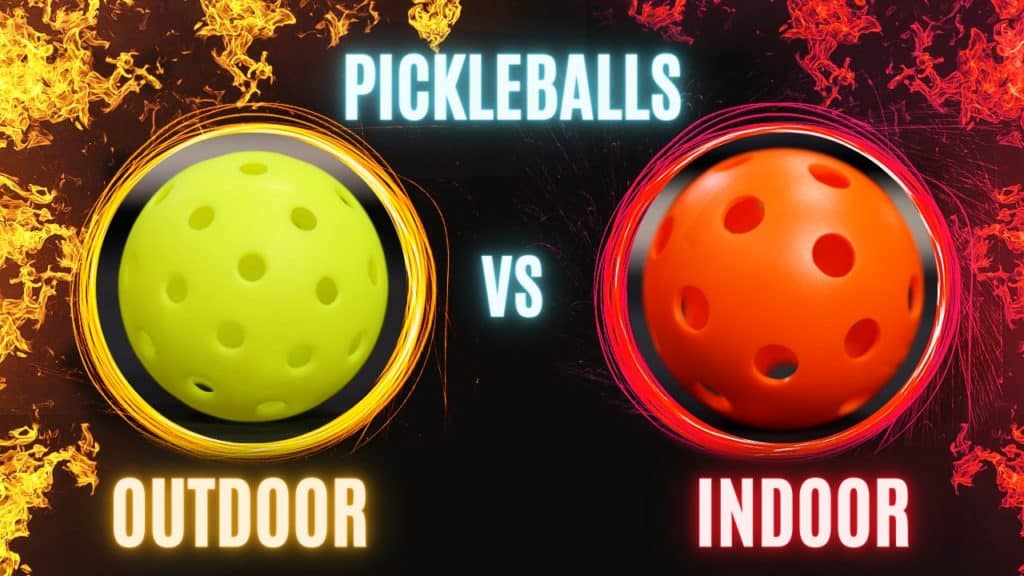
Why the Right Pickleball Matters?
You wouldn’t use a volleyball on a tennis court or vice versa. Likewise, matching your pickleball to the playing surface is important. Indoor and outdoor courts have distinct properties that affect factors like bounce, spin, control and playability. Using a ball engineered for each setting provides consistency and optimizes your performance.
What are Pickleballs?
Before comparing indoor and outdoor balls, let’s cover what exactly pickleballs are.
Pickleballs are plastic balls with a distinctive perforated surface used to play the paddle sport pickleball. Pickleballs may resemble wiffle balls, but they are engineered specifically for competitive play. The perforated surface creates an iconic look and unique “pop” sound when hit.
However, pickleball holes are strategically sized and placed to balance speed, bounce and aerodynamics. Thicker walls between holes prevent too much air escape. This gives pickleballs the lively bounce needed for rallies, compared to wiffle balls. The holes also generate spin and allow slower speeds for control.
Some key facts:
- Size – Pickleballs measure 2.9 inches in diameter, slightly smaller than a tennis ball. This reduces bounce.
- Weight – Balls weigh approximately 0.7 to 0.9 ounces. Lighter than a tennis ball for better control.
- Materials – Made of plastic, resin, or polymer.The type of material used depends on whether the ball is intended for indoor or outdoor use. Indoor balls are made of softer plastic than outdoor balls.The ball shall be made of a durable material molded with a smooth surface and free of texturing
- Holes – The distinctive holes all over the surface create an aerodynamic effect to reduce speed.
USA Pickleball Association Pickleball Ball Requirements
The USA Pickleball Association sets official standards for approved balls including size, weight, bounce height, and durability. It is important to note that only balls that meet these specifications are approved for use in regulated games and tournaments.
- Circumference – Minimal of 2.87″, maximal of 2.97″. The maximum out-of-round diameter variance shall not be greater than +/-0.020 inch.
- Weight – Between 0.78 to 0.935 ounces
- Bounce – pickleball must bounce between 30 to 34 inches high when dropped from a height of 78 inches onto a granite surface plate that is a minimum of 12 inches by 12 inches by 4 inches
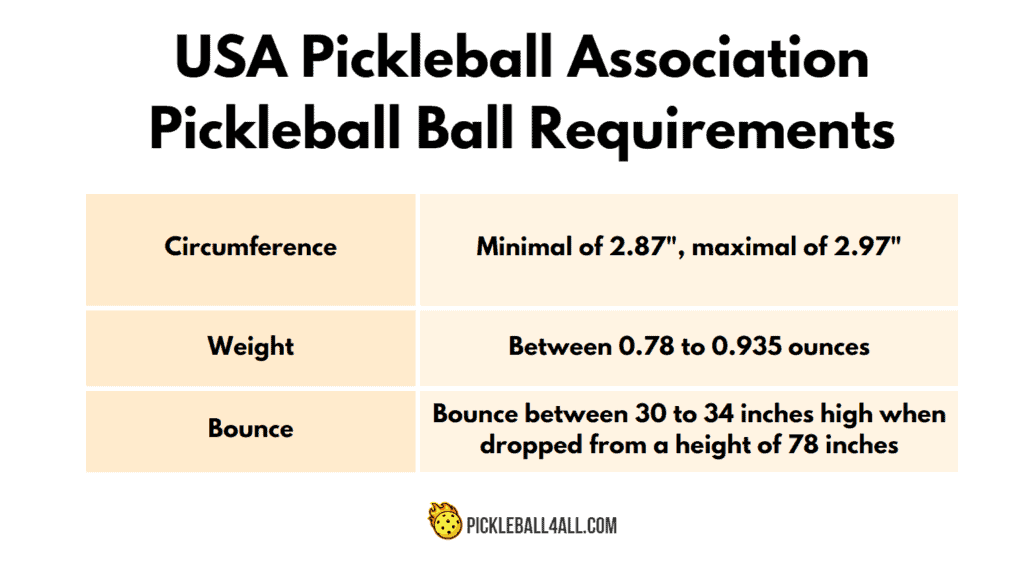
Common Pickleball Colors
Common pickleball colors are yellow, white, orange, pink, or green for high visibility. Brighter balls are used outdoors. Now let’s see how indoor and outdoor balls differ within these standards.
Indoor vs Outdoor Pickleballs Differences
The Basic Differences
Indoor and outdoor pickleballs differ in construction to suit their playing environment. Here are some key differences:
- Materials – Indoor balls use softer plastics to reduce noise. Outdoor balls use more durable plastics.
- Performance – Indoor balls have slightly lower bounce for controlled play on hard smooth courts. Outdoor balls bounce higher to compensate for outdoor surfaces.
- Durability – Outdoor balls are more rugged to resist abrasion from concrete and weather conditions. Indoor balls prioritize feel over durability.
- Holes – The indoor balls have approximately 26 larger holes, while outdoor balls have closer to 40 smaller holes. The larger holes in indoor balls lead to a softer feel and easier control.
The Hole Difference
The variation in hole patterns is a key technical difference between indoor and outdoor balls:
- Indoor balls have larger, fewer holes spaced further apart to provide:
- A softer feel upon impact for better control
- Increased surface grip from the wider holes
- Rapid air escape through large perforations for lower bounce
- Outdoor balls feature smaller, more numerous holes placed closer together to create:
- More structural integrity for outdoor handling
- Less friction and aerodynamic drag from smaller perforations
- Consistent bounce response across the surface
By tuning the hole size and layout for each ball type, manufacturers optimize performance for indoor versus outdoor play.
| Feature | Indoor Pickleballs | Outdoor Pickleballs |
|---|---|---|
| Number of Holes | 26 larger holes | 40 smaller holes |
| Hole Size | Larger | Smaller |
| Materials | Softer quiet plastics | More durable plastics |
| Bounce Height | Lower | Higher |
| Weight | Slightly lighter | Slightly heavier |
| Durability | Medium | High |
| Colors | Bright neons | Vibrant dyes |
| Best Use | Indoor smooth courts | Outdoor rough surfaces |
| Skill Level | Beginner to Intermediate | Intermediate to Advanced |
| Style of Play | Control and finesse | Power and spin |
Indoor Pickleballs: Features and Benefits
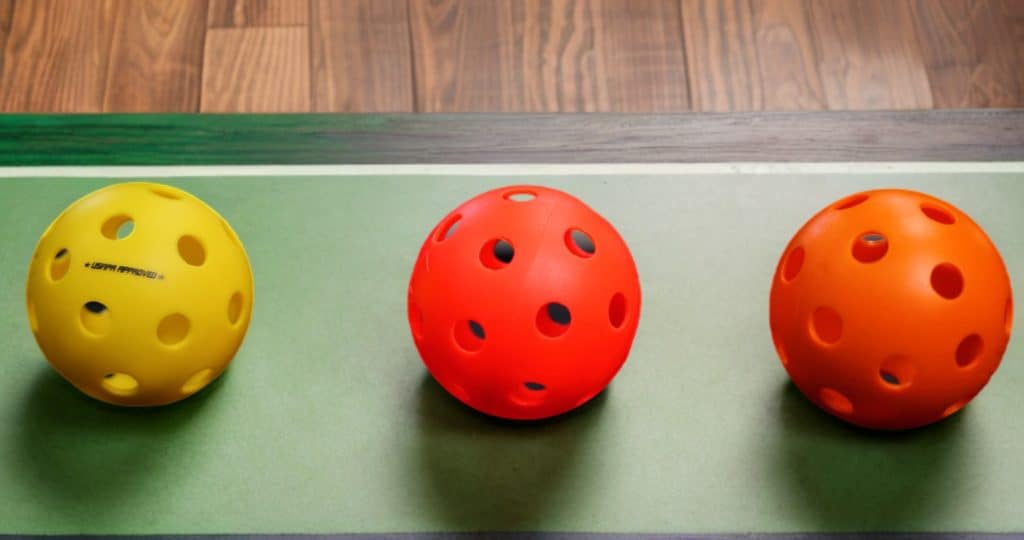
Indoor pickleballs are specifically designed for indoor use, providing a great way to enjoy the game of pickleball indoors when weather or other conditions make outdoor play impractical. They typically have larger holes than their outdoor counterparts, allowing them to glide more smoothly in an indoor environment with less airflow.
One of the major differences between indoor and outdoor pickleballs is that indoor versions tend to weigh slightly less. Indoor pickleballs are specially engineered for hard, smooth playing surfaces. They offer a unique playing experience due to their lighter weight and softer feel, which often suit the faster pace of indoor pickleball courts.
Despite their design for use indoors, some players also use indoor pickleballs outdoors in calm weather conditions, though they may not perform as optimally outside as they do inside. Furthermore, indoor pickleballs are typically made durable to withstand the potential harsh impacts against the floor and walls of indoor courts.
This durability makes them a cost-effective choice for enthusiasts who play indoor pickleball regularly. In conclusion, indoor pickleballs deliver several benefits, from enhanced durability to improved performance in an indoor setting, making them an ideal choice for those who prefer to play pickleball indoors.
Indoor pickleballs are engineered for hard, smooth playing surfaces. Let’s explore their specialized qualities.
Features of Indoor Balls
- More holes – Indoor balls have approximately 26 larger perforations compared to outdoor balls.
- Quieter materials – Made of soft plastics like polyethylene to reduce noise.
- Lower bounce – Bounce is slightly lower than outdoor balls.
- Lightweight – Weigh slightly less than outdoor balls for better control.
- Bright colors – Vibrant dyes like neon orange are highly visible.
Benefits for Indoor Play
The larger holes and lower bounce of indoor balls provide key advantages:
For lightning-fast volleys and rallies indoors, always choose balls marketed as “Indoor Pickleballs”. They’ll maximize your performance.
How Indoor Balls Perform
The larger holes and lower bounce of indoor balls allow them to move fast across indoor hardcourts, but land predictably without sharp sideways hops. Shots stay on a consistent trajectory, enabling reliable placement. This consistency boosts players’ confidence in shot-making.
Benefits for Beginners
The slightly lower bounce arc and forgiving nature of indoor balls builds confidence in novice players. Beginners can focus on proper swinging technique, footwork and shot basics without worrying about unpredictable bounces. The indoor ball helps new players gain experience sustaining rallies back and forth.
Advantages for Specific Shots
- The grippy surface easily creates heavy topspin forehands or sliced backhands with spin.
- The soft feel provides excellent touch for carefully aimed dinks and drops.
- The quietness aids communication between partners to coordinate strategy.
So whether you’re a pickleball pro looking to add to your shot repertoire or a novice starting on your journey, indoor pickleballs optimize play on hard interior courts. Be sure to use a ball labeled “Indoor” or “Indoor Court” for the best experience and safety. With the right indoor ball, you’ll enjoy consistent, high-level play each time you step on an indoor court.
Outdoor Pickleballs: Features and Benefits
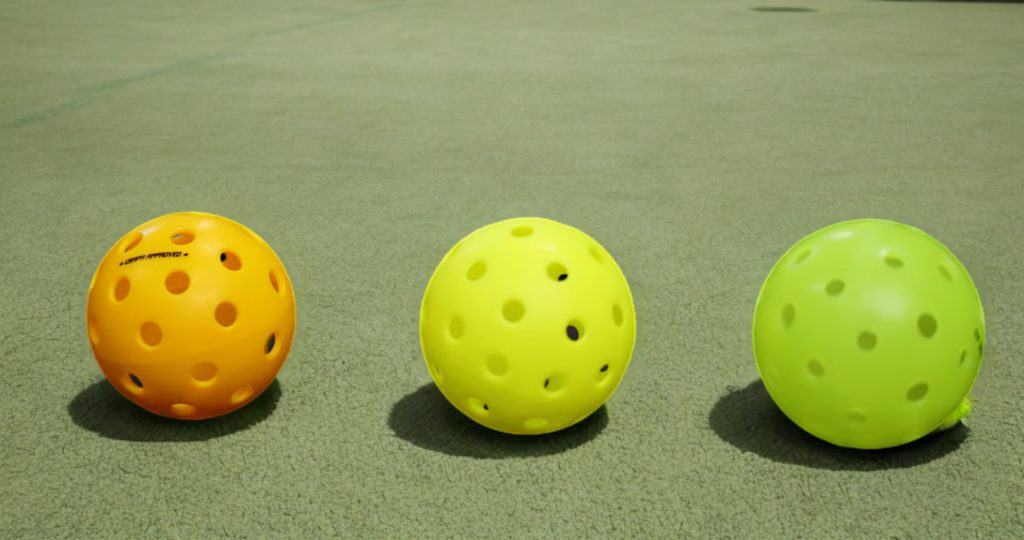
Outdoor pickleball is played on exterior courts, so the balls are designed to handle unpredictable surfaces like concrete or asphalt. This makes the sport quite different compared to indoor pickleball.
Outdoor pickleballs are made more rugged and durable. Importantly, they typically have smaller and more numerous holes compared to indoor balls. The larger number of small holes in outdoor balls reduces wind resistance, optimizing them for outdoor play.
Conversely, trying to use an indoor pickleball with larger, fewer holes outdoors can diminish performance. Essentially, outdoor pickleballs don’t play as well when used in an indoor setting, just as indoor balls with fewer larger holes may fall short outdoors.
It’s also crucial to note that while using outdoor pickleballs both indoors and outdoors is possible, for ideal performance it’s recommended to use balls engineered specifically for each playing environment.
In summary, both indoor and outdoor balls provide unique advantages suited to their court surface through purposeful hole pattern design. Matching the pickleball hole specs to where you play enhances the experience and gameplay.
Features of Outdoor Balls
- More holes – Outdoor balls have approximately 40 smaller perforations compared to indoor balls.
- Durable plastics – Made of hardy materials like resin to withstand outdoor elements.
- Higher bounce – Bounce is slightly higher than indoor balls.
- Heavier – Weigh slightly more than indoor balls for stability.
- Vibrant colors – Bright dyes like neon yellow are easy to see.
Outdoor balls come in different hardness levels, with some being harder than others. A harder ball is less likely to warp but more likely to crack, while a softer ball gets softer over time. The hardness of the ball affects the gameplay and requires players to adapt their style.
Benefits for Outdoor Play
The smaller holes and higher bounce of outdoor balls provide advantages:
For rugged and fast-paced outdoor matches, always use balls labeled “Outdoor” to optimize your game.
How Outdoor Balls Perform
The smaller holes and higher bounce of outdoor balls allow them to withstand wind and uneven outdoor surfaces. The ball maintains trajectory in gusts, and the lively bounce compensates for court inconsistencies.
Benefits for Advanced Players
The fast pace suits competitive matches and athletic exchanges. The hole design lends itself to forceful volleys and drives. The visibility aids quick reactions. The ruggedness permits intense practice sessions.
Advantages for Power Shots
- The heavier weight produces solid momentum for spins and speed on serves.
- The bouncy response generates pace for aggressive groundstroke returns.
- The compression on impact creates a satisfying “pop” on volleys.
In summary, outdoor pickleballs deliver rugged performance tailored to unpredictable exterior conditions. Their durable construction and lively bounce keep outdoor games going strong in the sun, wind, and rough terrain. Advanced players can utilize their full power and spin potential without holding back.
Yet the bright colors and robust build also provide new players the confidence to move outside and develop their games in an open-air court. For your next outdoor match, make sure to use balls labeled “Outdoor” and experience the freedom of all-weather performance.
What is a Hybrid Pickleball?
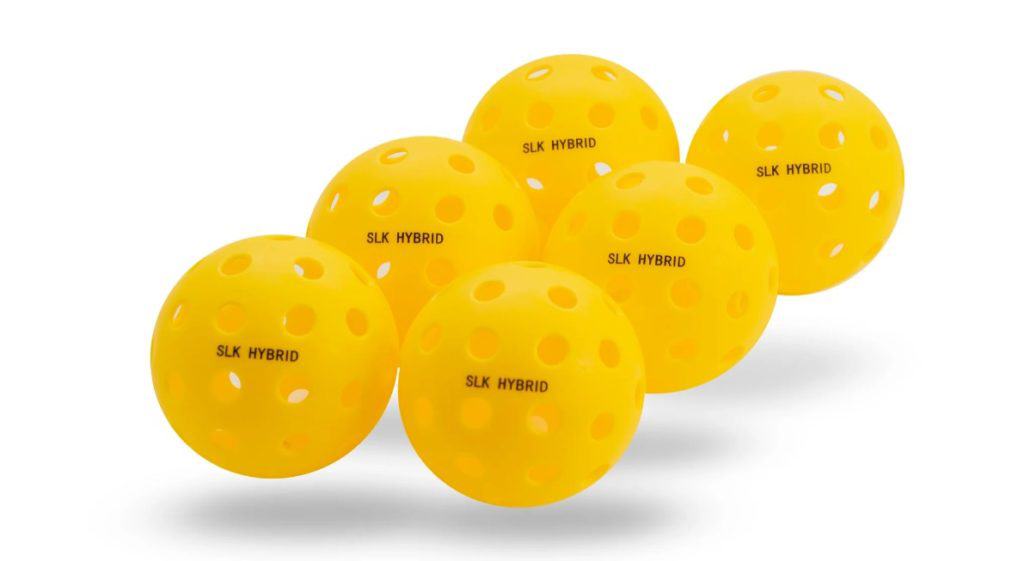
Hybrid pickleballs are designed to be played both indoors and outdoors, offering a versatile option for players who want to use the same ball in different settings. Here’s what you need to know about hybrid pickleballs:
- Hybrid pickleballs are made of a combination of materials that make them suitable for both indoor and outdoor play.
- The materials used in hybrid pickleballs are typically softer than those used in outdoor balls but harder than those used in indoor balls.
- Hybrid pickleballs have a balance of features that make them suitable for both indoor and outdoor play, such as a moderate bounce, predictable flight, and good durability.
- Hybrid pickleballs typically have a similar number of holes to outdoor balls, but the holes may be larger to provide better grip on indoor surfaces.
- Hybrid pickleballs come in a variety of colors, including green, yellow, and neon green.
- Hybrid pickleballs are available in sets of three or six balls, depending on the manufacturer.
When choosing a hybrid pickleball, it’s important to consider the specific features of the ball, such as its bounce, flight, and durability, as well as the playing conditions and court surface. Hybrid pickleballs can be a good option for players who want to use the same ball in different settings, but it’s important to choose a high-quality ball that will perform well in both indoor and outdoor environments
Choosing the Right Pickleball for Your Game
Now that you know the key differences between indoor and outdoor balls, how do you pick the best option for your needs? Here are some tips:
Factors to Consider
Consider the visual setbacks of colorblind players and the scenery/color of the court when choosing a ball.:
- Colorblind players may have difficulty seeing certain colored balls, so it’s important to choose a ball that contrasts well with the player’s surroundings.
- The color of the court can also affect which ball is best to use. For example, a blue court may make a blue ball blend in, while a green court may make a green ball blend in.
- Different brands offer two to four colors in each style of ball, so you have options.
- You may want to consider the color of the court you’ll be playing on or any color blindness.
Selecting Your Ball
Follow this process when choosing balls:
- Decide if you will mostly play indoors or outdoors.
- Consult your local pickleball association’s approved ball list.
- Read ball specs and descriptions to understand differences.
- Buy a few varieties to test and determine your favorite.
- Stick with a consistent ball type/brand for best play.
- Replace balls showing significant wear for ideal performance.
Investing in the right balls for your game environment will immediately pay dividends in improved skills, consistency, and enjoyment on the court. Don’t settle for the wrong ball – unleash your full potential by selecting balls purpose-built for how and where you play.
Top Pickleballs on the Market for Indoor, Outdoor, and Hybrid Play
Top Indoor Pickleballs on the Market
Onix Pure 2 Indoor Pickleballs
Jugs Indoor Pickleballs
Best Value
Franklin Sports X-26 Indoor Pickleballs
Top Outdoor Pickleballs on the Market
Onix Fuse Outdoor Pickleballs
Dura Fast 40 Outdoor Pickleballs
Best Value
Franklin Sports X-40 Outdoor Pickleballs
Hybrid Pickleballs on the Market
Best Value
SLK Hybrid Pickleball
These pickleballs are popular among players and are known for their quality, durability, and performance. When choosing a pickleball, it’s important to consider the playing conditions and court surface, as well as the specific features of the ball, such as its bounce, flight, and durability. Using the right type of pickleball for optimal play comfort is key to having the best playing experience
Conclusion
When it comes to pickleball, one ball does not fit all playing conditions. By understanding the specialized differences between indoor and outdoor balls, you can choose the right option to maximize your performance.
Indoor balls offer quiet games, low bounce, exceptional control and spin potential for fast indoor courts. Outdoor balls provide hardy durability, visibility, and consistent bounces to handle unpredictable outdoor environments.
Whichever you choose, be sure to use balls labeled specifically for your playing surface. This ensures you get optimal playability and safety. Don’t just default to the first ball you see – to unleash your full potential, dial in the engineered advantages of your ball for where you play.
We encourage you to try top balls from both categories to determine which feel and response suits your game the best. It may take some experimentation to find your ideal match. But with the right balls for your court surface, skills, and style, you are sure to step up your pickleball and have more fun doing it.
FAQ
What type of pickleballs are made for indoor play?
Pickleballs are made with specific requirements in mind, and indoor pickleball balls are no exception.
Indoor pickleballs are made of a softer plastic and typically have larger holes than outdoor types. This design difference results in a slower, more predictable flight, making them the preferred option when you play indoors.
Can indoor pickleballs be used for outdoor play?
While technically indoor pickleball balls can be used outdoors, it’s not the most optimal choice. Since the type of plastic is softer and the holes are larger, indoor pickleballs tend to not perform as well under windy conditions or on rougher outdoor court surfaces. Therefore, it’s always better to use the right ball for the correct environment, i.e., indoor or outdoor.
What are the main differences between indoor and outdoor pickleball balls?
The primary 5 differences between indoor and outdoor pickleball balls include the type of pickleball (plastic), size and number of holes, weight, bounce, and the level of hardness.
Outdoor balls have smaller holes, usually 40, and are made of harder plastic. They’re also heavier and have a higher bounce rate. On the other hand, indoor pickleballs are softer, lighter, and have fewer, larger holes.
Is there a specific way pickleballs are made?
Yes, pickleballs are made in a specific manner. Generally, they’re constructed from a single piece of harder plastic for outdoor usage and softer plastic for indoor.
The type of pickleball plastic is then heated, poured into molds, and allowed to cool to create the desired shape and hardness. The number of holes, typically around 40 holes for outdoor balls, are then drilled into the plastic.
Why do outdoor pickleballs weigh more than indoor ones?
Outdoor pickleballs are made with a harder than indoor type of plastic, which inherently makes them heavier. The denser materials can withstand the tougher outdoor playing conditions, while their extra weight helps to resist the wind and keeps the ball moving in the intended direction.
The basic construction of outdoor pickleballs often includes a thicker wall, contributing further to the overall weight. All these design elements make outdoor pickleballs more superior and durable for outdoor play and help to provide consistent play, no matter what the weather conditions are.
What is the best pickleball brand for indoor or outdoor play?
The top brands are Onix, Franklin, Jugs, Selkirk. Try a variety to find your favorite.
How do I know when to replace my worn balls?
Replace balls that are losing their bounce, popping sound, or show significant abrasions. Indoor balls may need replacing more often.
What pickleball color is best for visibility?
Neon orange and yellow balls are ideal for indoor and outdoor visibility. Outdoor play may also use hot pink or bright green balls.
Can indoor and outdoor balls be used in tournaments?
Tournaments usually mandate the use of a specific USA Pickleball approved ball model to standardize play.
What ball do pros use in competition?
Pros typically use outdoor balls for most major tournaments held on outdoor courts. The exception is indoor US Open events.
What are the concerns with the hardness of a pickleball?
The hardness of a pickleball is an essential factor to consider. While harder balls are great for outdoor play as they can withstand wind and other elements, they’re also more prone to cracking and can be harder on the paddle. Indoor balls, being softer, reduce the noise level and are less likely to cause damage.
Does the uniform size of pickleballs matter?
The uniform size of the balls matters. While there’s only one type of ball used in pickleball, which is around 74mm in diameter, it’s crucial not to choose balls that deviate from this size, as it could potentially affect the course of the game.
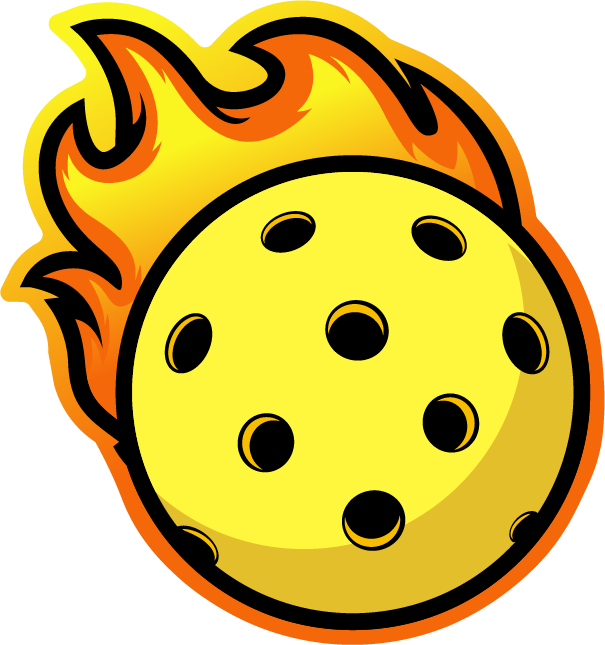
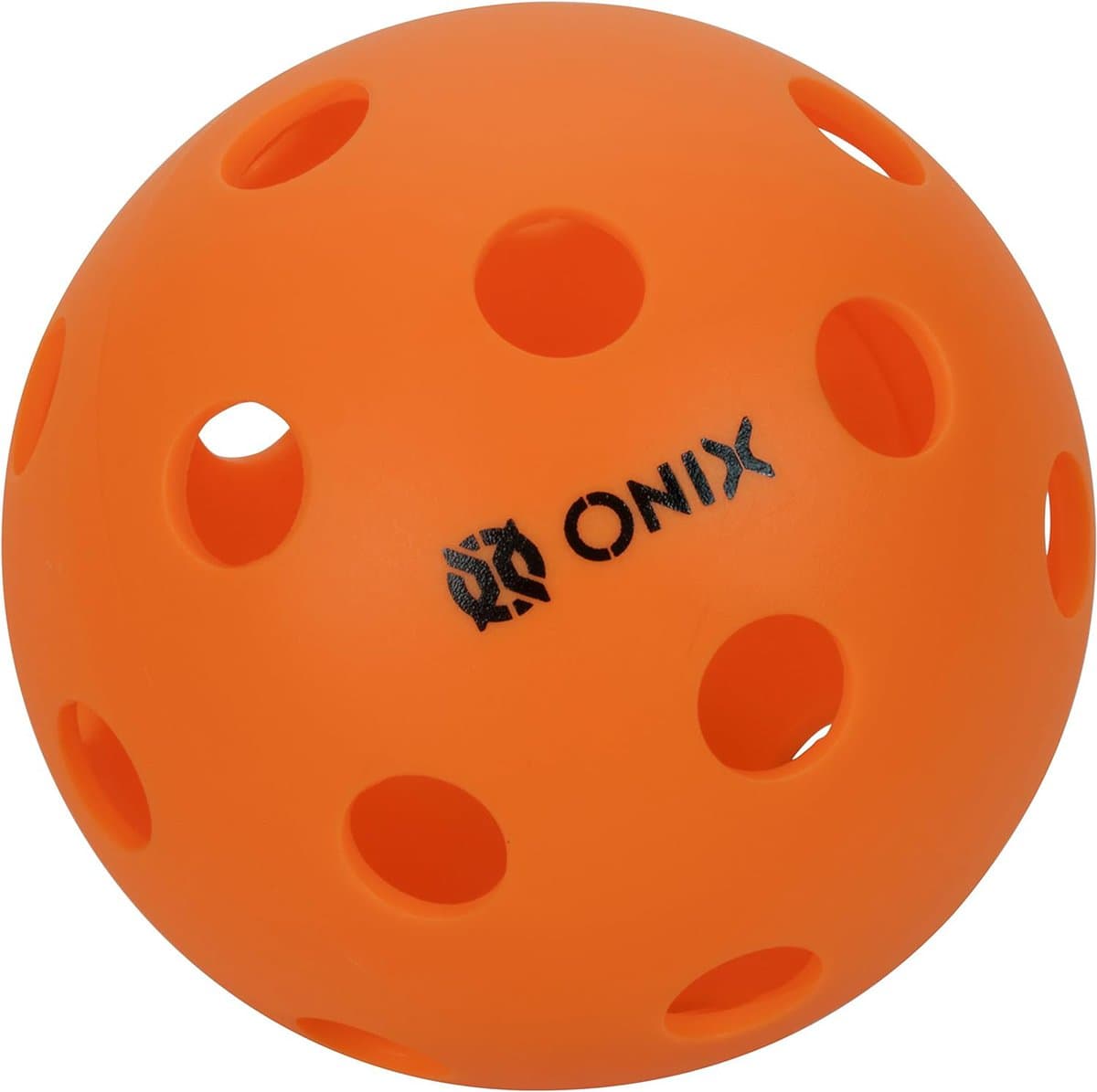
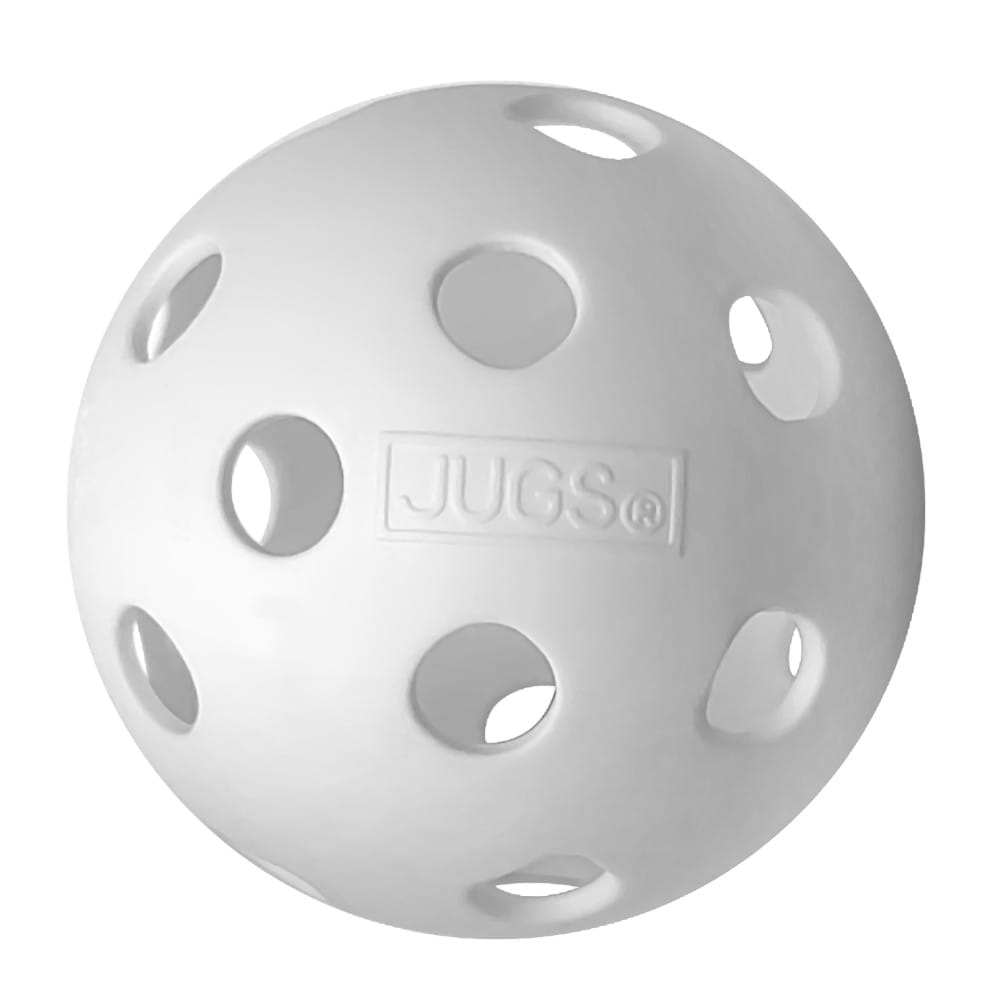
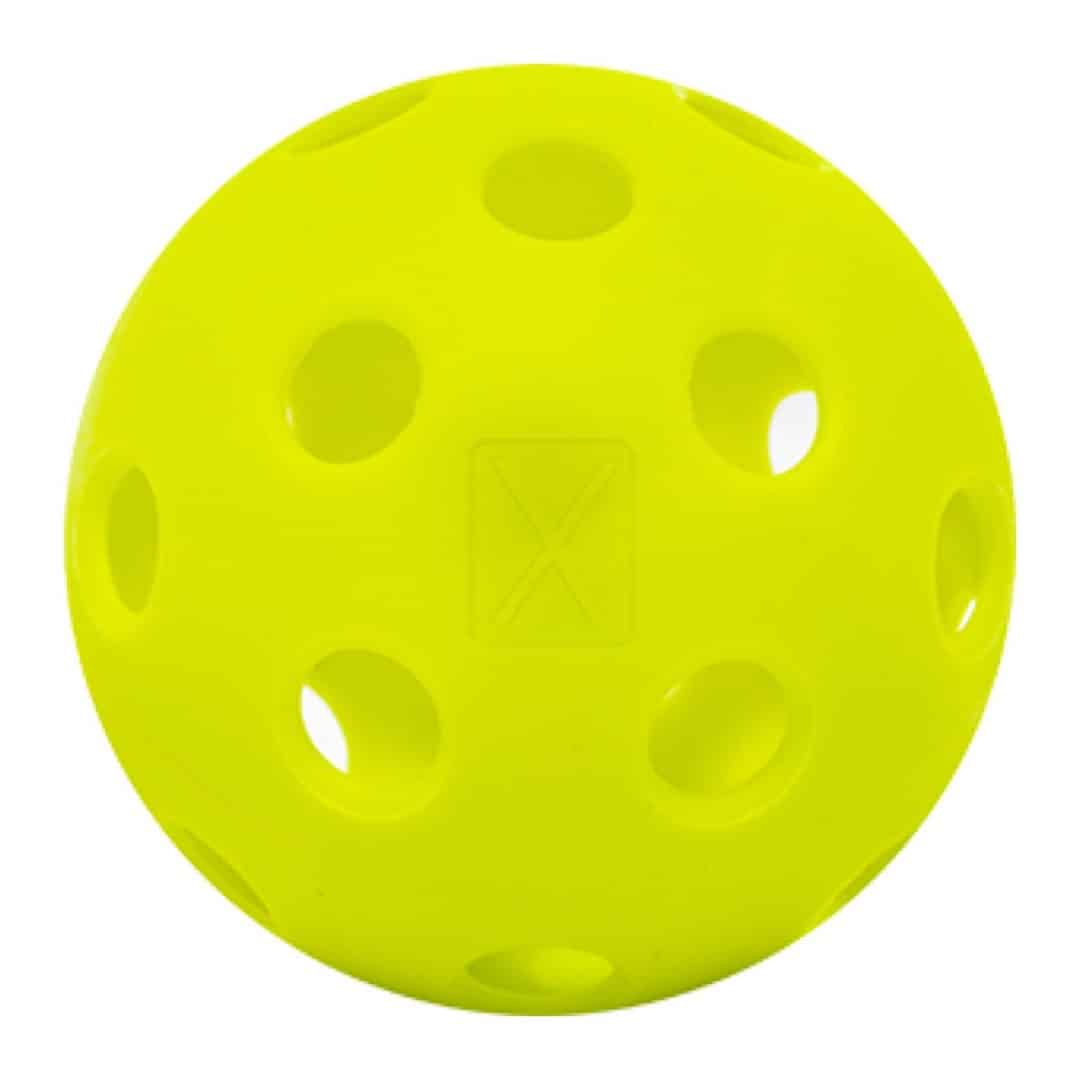
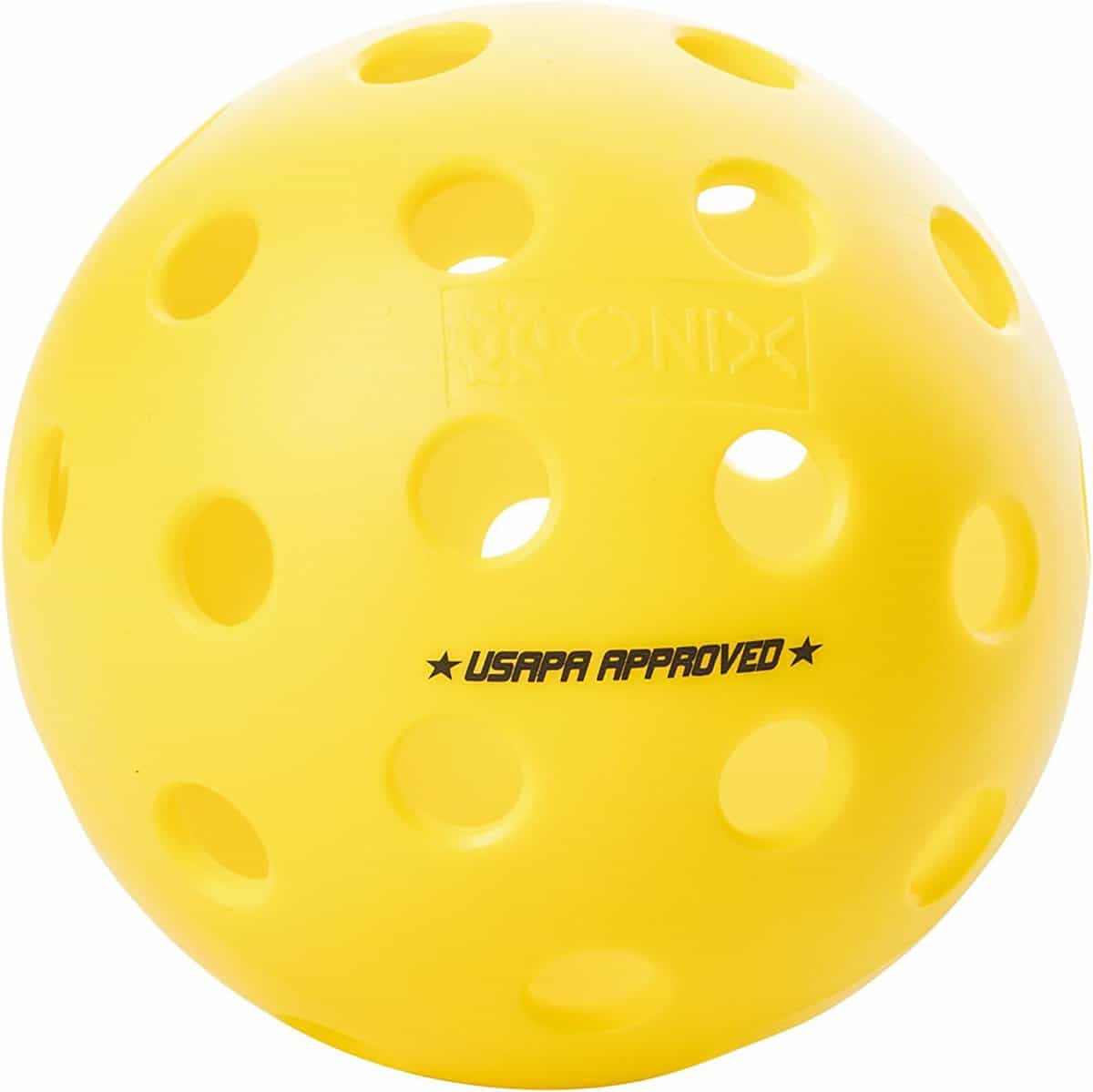
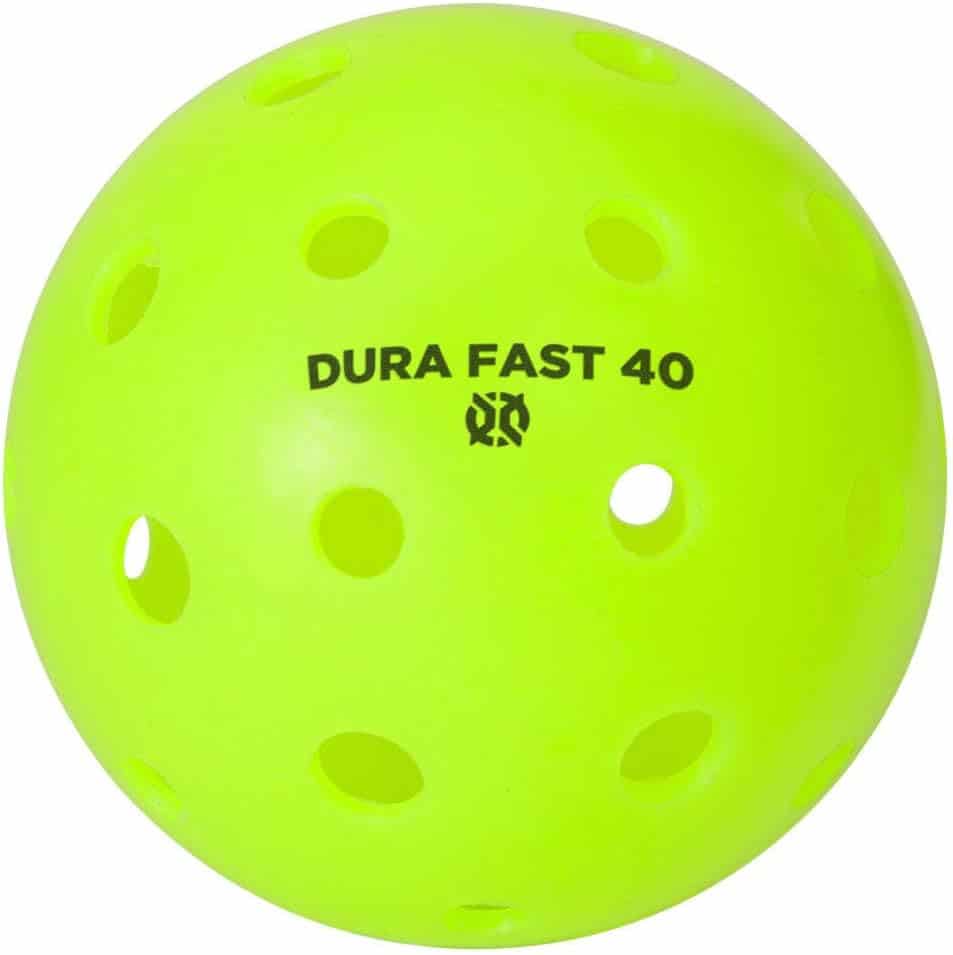
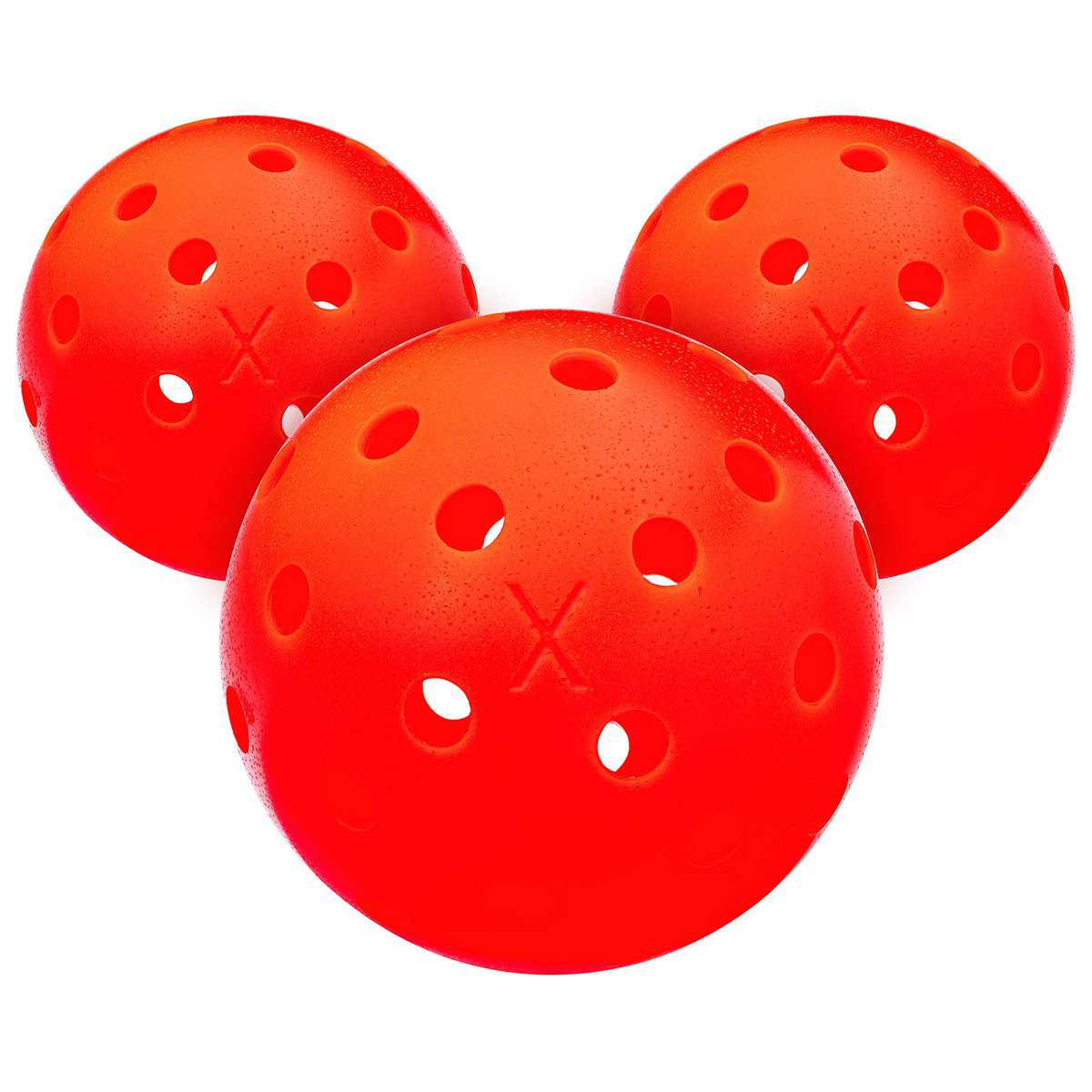

Hey, I’m Jack. Your blog is a game-changer! The content is insightful, well-researched, and always relevant. Great job!